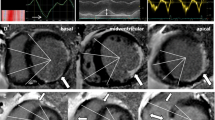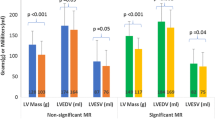Abstract
Ischemic mitral regurgitation (iMR) augments risk for right ventricular dysfunction (RVDYS). Right and left ventricular (LV) function are linked via common coronary perfusion, but data is lacking regarding impact of LV ischemia and infarct transmurality—as well as altered preload and afterload—on RV performance. In this prospective multimodality imaging study, stress CMR and 3-dimensional echo (3D-echo) were performed concomitantly in patients with iMR. CMR provided a reference for RVDYS (RVEF < 50%), as well as LV function/remodeling, ischemia and infarction. Echo was used to test multiple RV performance indices, including linear (TAPSE, S′), strain (GLS), and volumetric (3D-echo) approaches. 90 iMR patients were studied; 32% had RVDYS. RVDYS patients had greater iMR, lower LVEF, larger global ischemic burden and inferior infarct size (all p < 0.05). Regarding injury pattern, RVDYS was associated with LV inferior ischemia and infarction (both p < 0.05); 80% of affected patients had substantial viable myocardium (< 50% infarct thickness) in ischemic inferior segments. Regarding RV function, CMR RVEF similarly correlated with 3D-echo and GLS (r = 0.81–0.87): GLS yielded high overall performance for CMR-evidenced RVDYS (AUC: 0.94), nearly equivalent to that of 3D-echo (AUC: 0.95). In multivariable regression, GLS was independently associated with RV volumetric dilation on CMR (OR − 0.90 [CI − 1.19 to − 0.61], p < 0.001) and 3D echo (OR − 0.43 [CI − 0.84 to − 0.02], p = 0.04). Among patients with iMR, RVDYS is associated with potentially reversible processes, including LV inferior ischemic but predominantly viable myocardium and strongly impacted by volumetric loading conditions.





Similar content being viewed by others
Abbreviations
- ASE:
-
American Society of Echocardiography
- CAD:
-
Coronary artery disease
- CI:
-
Confidence interval
- CMR:
-
Cardiac magnetic resonance
- Echo:
-
Echocardiography
- ESV:
-
End-systolic volume
- EDV:
-
End-diastolic volume
- EF:
-
Ejection fraction
- GLS:
-
Global longitudinal strain
- iMR:
-
Ischemic mitral regurgitation
- LV:
-
Left ventricle
- MI:
-
Myocardial infarction
- MR:
-
Mitral regurgitation
- NYHA:
-
New York Heart Association
- PA:
-
Pulmonary artery
- PH:
-
Pulmonary hypertension
- ROC:
-
Receiver operating characteristics
- RV:
-
Right ventricle
- RVDYS :
-
Right ventricular dysfunction
- S′:
-
Systolic excursion velocity
- SPECT:
-
Single-photon emission computed tomography
- TAPSE:
-
Tricuspid annular plane systolic excursion
References
Klima UP, Guerrero JL, Vlahakes GJ (1999) Myocardial perfusion and right ventricular function. Ann Thorac Cardiovasc Surg 5:74–80
Kim J, Di Franco A, Seoane T, Srinivasan A, Kampaktsis PN, Geevarghese A et al (2016) Right ventricular dysfunction impairs effort tolerance independent of left ventricular function among patients undergoing exercise stress myocardial perfusion imaging. Circ Cardiovasc Imaging 9:e005115
Maddahi J, Berman DS, Matsuoka DT, Waxman AD, Forrester JS, Swan HJ (1980) Right ventricular ejection fraction during exercise in normal subjects and in coronary artery disease patients: assessment by multiple-gated equilibrium scintigraphy. Circulation 62:133–140
Brown KA, Okada RD, Boucher CA, Strauss HW, Pohost GM (1984) Right ventricular ejection fraction response to exercise in patients with coronary artery disease: influence of both right coronary artery disease and exercise-induced changes in right ventricular afterload. J Am Coll Cardiol 3:895–901
Sabe MA, Sabe SA, Kusunose K, Flamm SD, Griffin BP, Kwon DH (2016) Predictors and prognostic significance of right ventricular ejection fraction in patients with ischemic cardiomyopathy. Circulation 134:656–665
Greenwood JP, Maredia N, Younger JF, Brown JM, Nixon J, Everett CC et al (2012) Cardiovascular magnetic resonance and single-photon emission computed tomography for diagnosis of coronary heart disease (CE-MARC): a prospective trial. Lancet 379:453–460
Gorter TM, Lexis CP, Hummel YM, Lipsic E, Nijveldt R, Willems TP et al (2016) Right ventricular function after acute myocardial infarction treated with primary percutaneous coronary intervention (from the glycometabolic intervention as adjunct to primary percutaneous coronary intervention in ST-segment elevation myocardial infarction III trial). Am J Cardiol 118:338–344
Larose E, Ganz P, Reynolds HG, Dorbala S, Di Carli MF, Brown KA et al (2007) Right ventricular dysfunction assessed by cardiovascular magnetic resonance imaging predicts poor prognosis late after myocardial infarction. J Am Coll Cardiol 49:855–862
Di Franco A, Kim J, Rodriguez-Diego S, Khalique O, Siden JY, Goldburg SR et al (2017) Multiplanar strain quantification for assessment of right ventricular dysfunction and non-ischemic fibrosis among patients with ischemic mitral regurgitation. PLoS ONE 12:e0185657
Kim J, Medicherla CB, Ma CL, Feher A, Kukar N, Geevarghese A et al (2016) Association of right ventricular pressure and volume overload with non-ischemic septal fibrosis on cardiac magnetic resonance. PLoS ONE 11:e0147349
Klem I, Heitner JF, Shah DJ, Sketch MH Jr, Behar V, Weinsaft J et al (2006) Improved detection of coronary artery disease by stress perfusion cardiovascular magnetic resonance with the use of delayed enhancement infarction imaging. J Am Coll Cardiol 47:1630–1638
Cerqueira MD, Weissman NJ, Dilsizian V, Jacobs AK, Kaul S, Laskey WK et al (2002) Standardized myocardial segmentation and nomenclature for tomographic imaging of the heart. A statement for healthcare professionals from the Cardiac Imaging Committee of the Council on Clinical Cardiology of the American Heart Association. Circulation 105:539–542
Weinsaft JW, Kim J, Medicherla CB, Ma CL, Codella NC, Kukar N et al (2016) Echocardiographic algorithm for post-myocardial infarction LV thrombus: a gatekeeper for thrombus evaluation by delayed enhancement CMR. JACC Cardiovasc Imaging 9:505–515
Lang RM, Badano LP, Mor-Avi V, Afilalo J, Armstrong A, Ernande L et al (2015) Recommendations for cardiac chamber quantification by echocardiography in adults: an update from the American Society of Echocardiography and the European Association of Cardiovascular Imaging. Eur Heart J Cardiovasc Imaging 16:233–270
Rudski LG, Lai WW, Afilalo J, Hua L, Handschumacher MD, Chandrasekaran K et al (2010) Guidelines for the echocardiographic assessment of the right heart in adults: a report from the American Society of Echocardiography endorsed by the European Association of Echocardiography, a registered branch of the European Society of Cardiology, and the Canadian Society of Echocardiography. J Am Soc Echocardiogr 23:685–713 (quiz 86–8)
Lang RM, Badano LP, Mor-Avi V, Afilalo J, Armstrong A, Ernande L et al (2015) Recommendations for cardiac chamber quantification by echocardiography in adults: an update from the American Society of Echocardiography and the European Association of Cardiovascular Imaging. J Am Soc Echocardiogr 28:1–39
Srinivasan A, Kim J, Khalique O, Geevarghese A, Rusli M, Shah T et al (2017) Echocardiographic linear fractional shortening for quantification of right ventricular systolic function: a cardiac magnetic resonance validation study. Echocardiography 34:348–358
Zoghbi WA, Adams D, Bonow RO, Enriquez-Sarano M, Foster E, Grayburn PA et al (2017) Recommendations for noninvasive evaluation of native valvular regurgitation: a report from the American Society of Echocardiography developed in collaboration with the society for cardiovascular magnetic resonance. J Am Soc Echocardiogr 30:303–371
Devereux RB, Alonso DR, Lutas EM, Gottlieb GJ, Campo E, Sachs I et al (1986) Echocardiographic assessment of left ventricular hypertrophy: comparison to necropsy findings. Am J Cardiol 57:450–458
Devereux RB, Roman MJ, Palmieri V, Liu JE, Lee ET, Best LG et al (2003) Prognostic implications of ejection fraction from linear echocardiographic dimensions: the Strong Heart Study. Am Heart J 146:527–534
Mauritz GJ, Vonk-Noordegraaf A, Kind T, Surie S, Kloek JJ, Bresser P et al (2012) Pulmonary endarterectomy normalizes interventricular dyssynchrony and right ventricular systolic wall stress. J Cardiovasc Magn Reson 14:5
Goldstein JA, Tweddell JS, Barzilai B, Yagi Y, Jaffe AS, Cox JL (1992) Importance of left ventricular function and systolic ventricular interaction to right ventricular performance during acute right heart ischemia. J Am Coll Cardiol 19:704–711
Zornoff LA, Skali H, Pfeffer MA, St John Sutton M, Rouleau JL, Lamas GA et al (2002) Right ventricular dysfunction and risk of heart failure and mortality after myocardial infarction. J Am Coll Cardiol 39:1450–1455
Lu KJ, Chen JX, Profitis K, Kearney LG, DeSilva D, Smith G et al (2015) Right ventricular global longitudinal strain is an independent predictor of right ventricular function: a multimodality study of cardiac magnetic resonance imaging, real time three-dimensional echocardiography and speckle tracking echocardiography. Echocardiography 32:966–974
van der Zwaan HB, Geleijnse ML, McGhie JS, Boersma E, Helbing WA, Meijboom FJ et al (2011) Right ventricular quantification in clinical practice: two-dimensional vs. three-dimensional echocardiography compared with cardiac magnetic resonance imaging. Eur J Echocardiogr 12:656–664
Ishizu T, Seo Y, Atsumi A, Tanaka YO, Yamamoto M, Machino-Ohtsuka T et al (2017) Global and regional right ventricular function assessed by novel three-dimensional speckle-tracking echocardiography. J Am Soc Echocardiogr 30:1203–1213
Le Tourneau T, Deswarte G, Lamblin N, Foucher-Hossein C, Fayad G, Richardson M et al (2013) Right ventricular systolic function in organic mitral regurgitation: impact of biventricular impairment. Circulation 127:1597–1608
Acknowledgements
This study was supported by National Institutes of Health (Grant Nos. 1K23 HL140092-01 and 1R01HL128278-01).
Author information
Authors and Affiliations
Corresponding author
Ethics declarations
Conflict of interest
The authors declare that they have no conflict of interest.
Rights and permissions
About this article
Cite this article
Kim, J., Alakbarli, J., Yum, B. et al. Tissue-based markers of right ventricular dysfunction in ischemic mitral regurgitation assessed via stress cardiac magnetic resonance and three-dimensional echocardiography. Int J Cardiovasc Imaging 35, 683–693 (2019). https://doi.org/10.1007/s10554-018-1500-4
Received:
Accepted:
Published:
Issue Date:
DOI: https://doi.org/10.1007/s10554-018-1500-4




